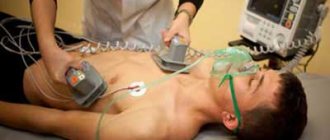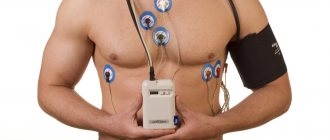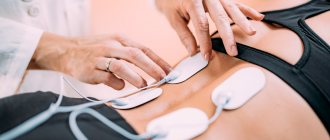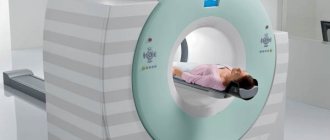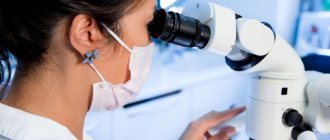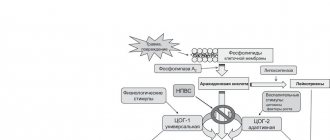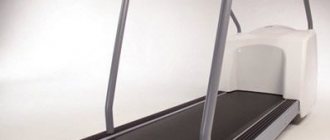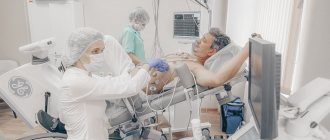There are diseases of the heart and blood vessels that are quite difficult to diagnose at an early stage. This happens due to the fact that some ailments manifest themselves most clearly during periods of physical activity.
To identify such disorders, special testing methods have been developed, based on taking readings with increasing load on the cardiovascular system. Bicycle ergometry, or VEM test, is an informative and non-invasive diagnostic tool of just this kind.
Bicycle ergometry is a recording of an ECG (electrocardiogram) during physical activity.
1
ECG in "MedicCity"
2 VEMs in “MedicCity”
3 Bicycle ergometry in the diagnosis of CVD
What is cardiac bicycle ergometry?
Professional athletes who undergo regular medical examinations are well aware of what bicycle ergometry is. But the exercise test is not only carried out within the framework of sports medicine. In cardiology, it is used to diagnose coronary heart disease even at the initial stage, when deficiency of cardiac muscle nutrition appears in the patient only during the period of activity, atherosclerosis. In pulmonology, a gas analysis test is used to identify pulmonary pathologies and lung volume.
The principle of the study is based on the fact that during physical activity the body reacts with a complex of physiological reactions. The patient's breathing and heart rate increase, oxygen consumption increases, and blood pressure increases.
Oxygen supplied to the muscles through the blood is involved in the redox reactions necessary to produce energy. The same thing happens with the heart, which is essentially a muscle. The organ is fed through the coronary vascular system. If abnormalities occur in the blood circulation, they are most pronounced during the period of physical activity.
Along with bicycle ergometry, there is a similar test in functional diagnostics: the treadmill test. The difference is that instead of bicycle ergometry during the treadmill test, the patient’s heart and blood vessels are measured during physical activity on a treadmill.
Interpretation of VEM results
Hardware data includes parameters such as:
- patient's performance level;
- heart rhythm, detected disturbances (if any);
- rate of recovery of blood pressure and heart rate;
- type of blood pressure response to exercise;
- severity of ischemia;
- time and reason for stopping testing, etc.
After interpretation of the data, the patient is given a conclusion.
There are 4 main forms of conclusion:
Negative VEM test - when the maximum load was reached, normal physiological parameters were preserved. IHD is excluded in most cases.
A positive result —the ECG shows changes indicating ischemia, often accompanied by an attack of angina.
A questionable result —the subject complained of pain, but there were no changes on the ECG.
Uninformative test - the study was not completed completely, the patient refused to continue testing due to dizziness, severe headache or convulsions, although there were no signs of coronary artery disease.
Despite all the information value of bicycle ergometry for most patients, the uncertainty of the results of a particular test may require the appointment of additional studies.
Decoding the treadmill test is practically no different from deciphering the VEM results. Normal indicators for the treadmill test, as well as the VEM test, are negative indicators.
Purpose of bicycle ergometry
The patient undergoes the study at his own discretion, on the direction of a doctor, trainer or employer. The purpose of bicycle ergometry depends on who is taking the test. In patients, the doctor uses a test to monitor the treatment process and identify diseases at an early stage.
Athletes are required to undergo regular medical examinations, which include bicycle ergometry. It helps determine the effectiveness of training, correctly dose physical activity, and diagnose hidden pathologies that can become an obstacle to work or a sports career.
Read also[edit | edit code]
- Functional movement abilities: mobility and stability
- Strength abilities
- Dynamometry (method of measuring muscle strength)
- Tests to assess absolute muscle strength using barbells and extreme weights
- Tests to assess speed-strength abilities and power
- Medball
- Tests to evaluate the special strength abilities of field players
- Speed abilities
- Tests to evaluate reaction speed
- Tests to evaluate the special speed abilities of field players
- Endurance tests
- Physical abilities of hockey players
- Coordination abilities
Bicycle ergometry technique
The examination of the heart and blood vessels is carried out by an experienced cardiologist. There is a specialist on duty in the office who is always ready to provide first aid if the patient’s health worsens during the test.
Tests take place in a spacious, well-lit room with a special microclimate. The room is maintained with ventilation, average atmospheric pressure, temperature 21 degrees, low humidity, insulation from noise and extraneous contacts.
The room is equipped with a bicycle ergometer - an exercise bike with a stepwise increasing load and an electrocardiograph for monitoring the patient’s heart rhythm. The office also contains a device for measuring blood pressure.
The office also has a couch, a defibrillator and a first aid pharmacy.
The test takes no more than 20 minutes, otherwise the patient will get tired. Before the test begins, the doctor records your weight and height, blood pressure, and resting heart rate. The patient sits on a bicycle ergometer and electrodes are attached to his body. Blood pressure control is carried out by an automated system.
The cardiologist selects the study protocol depending on the indications. Test methods depend on how the load is applied:
- continuous throughout the test;
- intermittent with a gradual increase in load and rest intervals;
- continuously increasing without pauses;
Electrocardiogram monitoring begins before the start of the test and ends after its completion. Monitoring of pressure and heart rate is carried out at each stop or at intervals of 2 minutes.
The optimal pedaling speed is 60 rpm: at it the level of aerobic exercise is maximum. But not all patients can withstand this speed. In this regard, the doctor, before starting the test, determines the upper limit of the power of the bicycle ergometer, based on the capabilities of the subject and based on special formulas.
If the patient cannot achieve the maximum power of the exercise bike, additional criteria for ending the test are provided: severe physical fatigue or the appearance of clinical symptoms requiring load limitation. The criteria include a decrease or increase in pressure, cyanosis of the skin, shortness of breath, dizziness, muscle pain, chest pain, and pronounced changes in heart rhythm. The listed symptoms in the patient that appeared during the study indicate the presence of cardiovascular pathology.
CHOICE
There are many different manufacturers of such devices, including brands such as Proxomed, Spotrsart, Matrix and others. But it’s better not to choose them yourself. You need to not only purchase a bicycle ergometer, but also take into account when using it an individual program drawn up for you by your attending physician based on your health conditions. Therefore, be sure to consult with a specialist and clarify with him what requirements are imposed on the device. And only then choose a suitable bicycle ergometer, more household or purely medical, within your capabilities and based on recommendations.
Bicycle ergometry: indications and contraindications
Cardiac examinations are prescribed for certain indications. Indications for bicycle ergometry are:
- complaints of chest pain in the absence of abnormalities in the cardiogram;
- hereditary cardiovascular diseases;
- previous cardiac surgery in adolescents and children (to assess effectiveness);
- suspicion of atherosclerosis or coronary heart disease;
- myocardial infarction (3 weeks after the illness);
- heart failure;
- heart rhythm disturbances;
- heart valve pathology;
- bronchopulmonary diseases;
- pathologies of blood vessels of the lower extremities.
Bicycle ergometry also has absolute contraindications when the test is dangerous to the patient’s life. Such conditions include aortic valve stenosis, angina pectoris, aortic aneurysm, inflammatory pathologies of the heart, acute or chronic diseases in the acute stage, and circulatory disorders in the brain. The test is not performed in the first 3 weeks after the onset of signs of myocardial infarction.
LET'S SUM IT UP
Bicycle ergometers, to describe them simply and briefly, are more accurate exercise bikes with the ability to more flexibly control loads and a number of additional functions. They are indispensable for rehabilitation, which is why they are often used in specialized institutions. If your goal is regular fitness, then you most likely will not need them, especially since their price is much higher than traditional devices. But if you have experienced or are still experiencing health problems, then you should definitely think about either exercising on such simulators in medical institutions, or purchasing them for home.
SOURCES: https://bodybuilding-and-fitness.ru/kardio/kardiotrenazhery/veloehrgometr.html https://proskopiyu.ru/metody/veloergometr.html
Bicycle ergometry: how to prepare
For maximum reliability of the results, the patient is required to prepare:
- During the day, do not drink coffee, alcoholic beverages, or smoke.
- On the day of testing, avoid stress and any physical activity.
- Breakfast the morning before the test should be light.
- Do not take medications that affect heart function or blood pressure. The doctor makes the decision about this.
To get reliable test results, make an appointment with a cardiologist at our medical center. The doctor will tell you in detail what bicycle ergometry shows, how the test is performed and how to prepare for it.
In our center, consultations are conducted by qualified doctors who have extensive experience in diagnosing and treating cardiovascular diseases. The latest Swiss equipment and spacious rooms make the test comfortable and the results reliable.
To undergo bicycle ergometry at an affordable price, make an appointment by phone at a convenient time. Patients can fill out an application on the website for the test, and operators will select a time for a visit to a cardiologist.
Preparation for the procedure
During an explanatory conversation between the doctor and his patient, the main points of the procedure are clarified and the tactics of the patient’s actions are discussed.
- The day before and on the day of the procedure, it is recommended to avoid stressful situations and not exert yourself physically;
- You must stop taking medications other than vital ones one day before the examination.
Important! Some medications cannot be stopped at once. The withdrawal regimen for certain types of drugs (beta blockers, cardiac glycosides, diuretics, calcium antagonists, hormones, etc.) should be prescribed by the attending physician in advance. Only hypoglycemic agents and anticoagulants are not canceled!
- Within 12 hours before bicycle ergometry, it is not advisable to smoke or drink alcohol or products containing caffeine. This is strictly prohibited 3 hours before the procedure;
- 12 hours before VEM, exclude all unusual physical activity;
- Light breakfast 2-3 hours before the test - a glass of juice or kefir with a slice of bread.
Benefits of doing exercises on a bicycle ergometer
Regular cycling brings real benefits to the body. But in Moscow, where, as a rule, there is no time for walking, and it is impossible to get from one part of the city to another without a car or public transport, buying a bicycle is not always rational. In this case, an exercise bike, in particular a bicycle ergometer, is an excellent solution.
This simulator is aimed at improving your health. It is required for:
- Workouts for legs, thighs and buttocks. Exercises promote muscle development, increase joint mobility, and make ligaments stronger.
- Preventing spinal problems. According to user reviews, the bicycle ergometer has a positive effect on the spine, and especially the lower back. The result of exercise is a reduction in the risk of osteochondrosis, radiculitis and other problems.
- Preserving beauty and health. “Rides” on the exercise machine make your figure slimmer, get rid of extra calories, change your posture, and make your gait more beautiful.
